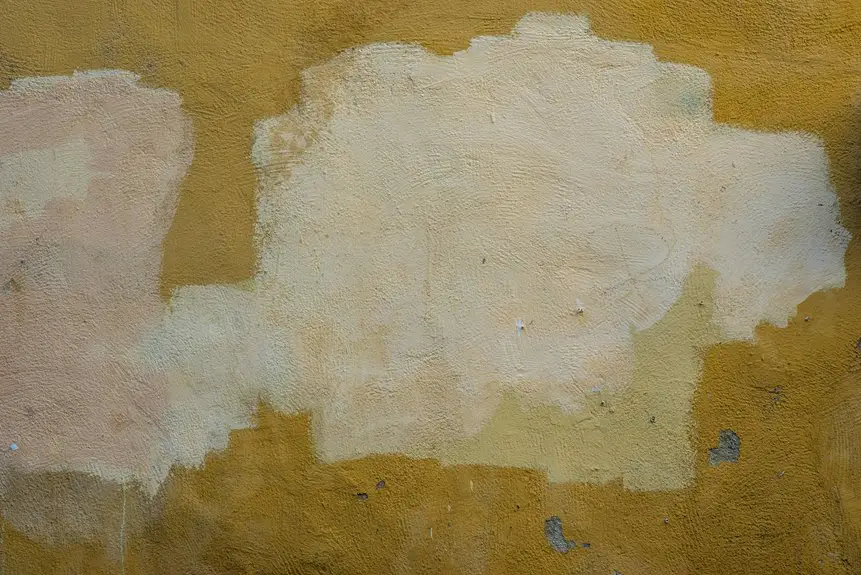To patch corduroy stylishly, start by cleaning your garment and selecting a patch fabric that matches its texture and weight. Use strong polyester thread and a heavy needle to stitch securely with running or whip stitches for durability. Try creative patch shapes or add embroidery for flair. Always wash patched corduroy gently to maintain its look. With thoughtful materials and techniques, you can turn repairs into a fashion statement and discover even more ways to personalize your pieces.
Table of Contents
Key Takeaways
- Use matching or contrasting sturdy fabrics like denim for patches to complement corduroy’s texture and add visual interest.
- Employ strong polyester thread with running, whip, or satin stitches for durable, neat attachment without puckering.
- Clean and thoroughly assess the corduroy for all damage spots before patching to ensure comprehensive repair.
- Incorporate decorative embroidery or layered patches to personalize and elevate the garment’s style.
- Follow gentle care instructions, like washing inside out and air drying, to preserve patched repairs and fabric integrity.
Understanding Corduroy Fabric and Common Damages
Corduroy’s distinctive ridged texture comes from its unique weave, which creates raised cords or wales.
Corduroy’s signature ridged texture is crafted by its special weave forming raised cords known as wales.
When you work with corduroy, you’ll notice these ridges give the fabric strength but also make it prone to specific damages. Common issues include worn-down areas where the pile flattens, small tears between the wales, and fraying at edges or seams.
Because the pile is delicate, rubbing or frequent washing can cause the fabric to lose its softness and pattern. You might also find holes caused by snagging on sharp objects or stress points in heavily used garments.
Understanding these weaknesses helps you spot damage early and choose the right repair technique to maintain your corduroy’s look and durability.
Essential Tools and Materials for Patching Corduroy
To patch corduroy effectively, you’ll need the right thread that matches both color and strength.
Picking a patch fabric that blends well with your garment is just as important.
Don’t forget essential sewing tools like needles, scissors, and pins to make the process smooth and precise.
Choosing the Right Thread
Anyone tackling a corduroy patch needs to pick the right thread to guarantee durability and a seamless look. Choose a thread that matches your corduroy’s color closely; this helps the repair blend in naturally.
Opt for a strong, polyester thread since it resists wear and stretching better than cotton. If your corduroy has a sheen, consider a thread with a slight sheen to mimic the fabric’s texture.
Avoid bulky threads that might create lumps or disrupt the corduroy’s ridges. Also, pick a thread weight suitable for your fabric’s thickness—usually a medium-weight thread works best.
Using the right thread ensures your patch holds up over time and complements the fabric’s unique texture, making your repair both sturdy and stylish.
Selecting Patch Fabrics
Picking the right thread sets the stage, but choosing the patch fabric itself plays an even bigger role in how well your repair will hold up and look.
You want a fabric that matches your corduroy’s weight and texture to keep the patch discreet and durable. Look for corduroy remnants or similar fabrics with a matching wale size—the ridges’ width—to blend seamlessly.
If you can’t find an exact match, a contrasting fabric can create a stylish accent. Cotton or cotton blends work best since they’re sturdy yet flexible.
Avoid slippery or overly stretchy materials; they won’t hold up well. Make sure the patch fabric is prewashed to prevent shrinking later.
Selecting the right fabric sets the foundation for a patch that’s both functional and fashionable.
Essential Sewing Tools
Successful corduroy patching depends as much on the right tools as on your fabric choice.
You’ll need sharp fabric scissors to cut clean, precise patches without fraying edges. A needle designed for heavy fabrics, like a denim or upholstery needle, will make stitching easier and prevent breakage. Choose a strong, matching thread—polyester blends work well for durability.
A seam ripper helps remove old stitches without damaging the fabric. Don’t forget pins or fabric clips to hold your patch securely in place while you sew. An iron and pressing cloth are essential for flattening seams and ensuring a smooth finish.
Having a thimble can protect your fingers when pushing the needle through thick corduroy. With these tools, you’ll patch your corduroy like a pro.
Preparing Corduroy for Repair: Cleaning and Assessing Damage
Before you start patching corduroy, take a close look at the fabric to identify all areas that need repair. Clean the garment by gently washing or spot-cleaning to remove dirt and oils, which can interfere with patch adhesion. After drying, inspect the fabric for tears, worn spots, or thinning pile. Evaluating damage thoroughly helps you plan your repair approach effectively.
| Damage Type | Description |
|---|---|
| Small Tear | Short rip, edges usually clean |
| Frayed Edges | Threads unraveling at damage |
| Thin Pile | Worn down fabric surface |
| Stains | Discoloration or spots |
| Holes | Missing fabric pieces |
This evaluation guarantees you address all problem areas before sewing on patches.
Techniques for Sewing Patches on Corduroy
When sewing patches on corduroy, you’ll want to pick materials that match its texture and weight.
Knowing the right stitching methods helps your patch stay secure without damaging the fabric.
You’ll also learn how to blend the patch seamlessly so it looks natural and lasts longer.
Choosing Patch Materials
Although corduroy’s textured surface can make patching a bit tricky, choosing the right materials guarantees your repairs hold up and look great.
You’ll want to pick patches made from sturdy fabrics that complement corduroy’s thickness, like denim, canvas, or even another piece of corduroy. Avoid lightweight or stretchy fabrics—they won’t provide enough support and may wear out quickly.
Matching the color and texture closely helps your patch blend in, but don’t hesitate to use contrasting fabrics for a bold, stylish statement.
Also, consider using fusible interfacing behind the patch for extra stability before sewing. Picking quality thread that’s strong and color-coordinated ensures your stitches stay secure without standing out.
With the right materials, your patch will be durable and visually appealing.
Stitching Methods Overview
Mastering three key stitching methods will help you secure patches on corduroy effectively.
First, the running stitch offers a simple, quick way to attach patches by sewing small, even stitches along the edges.
Second, the whip stitch wraps thread around the patch’s edge, providing a strong hold and preventing fraying.
Finally, the satin stitch involves closely spaced stitches that cover the patch’s border completely, ensuring durability and a polished look.
When working with corduroy’s ridged texture, keep your stitches consistent in size and tension to avoid puckering.
Use a sharp needle designed for thick fabrics and choose a thread color that complements your patch.
Blending Patch With Corduroy
To blend a patch seamlessly with corduroy, you’ll need to contemplate both fabric texture and color harmony. Choose a patch that matches the wale width and direction to maintain the corduroy’s distinctive ribbed texture.
If the patch’s color is slightly off, consider fading it gently with water or a mild dye to achieve a closer match. When sewing, use matching thread and small, tight stitches that follow the ribs’ vertical lines. This approach prevents the patch from standing out.
Press the patch carefully with a warm iron to flatten seams and integrate the patch into the fabric. Taking these steps guarantees your repair looks intentional, stylish, and nearly invisible, preserving the unique character of your corduroy garment while extending its life.
Creative Patch Ideas to Enhance Your Corduroy Pieces
Adding patches to your corduroy pieces lets you showcase your personal style while giving new life to worn or plain areas.
Patching corduroy breathes fresh style into worn spots, turning repairs into unique fashion statements.
You can turn simple repairs into eye-catching features that make your clothing truly unique. Here are three creative patch ideas to enhance your corduroy:
- Mix Textures: Combine corduroy with denim or leather patches for a bold contrast that adds dimension.
- Play with Shapes: Use geometric or asymmetrical patches instead of traditional squares to create dynamic visual interest.
- Add Embroidery: Personalize patches with embroidered designs or initials to make your corduroy piece one-of-a-kind.
Try these ideas to transform any faded or damaged corduroy item into a stylish statement piece that reflects your creativity and flair.
Tips for Matching Thread and Patch Colors With Corduroy
When you choose thread and patch colors for your corduroy, consider both harmony and contrast to make your repairs stand out or blend seamlessly. If you want your patch to blend, pick thread and fabric shades that closely match your corduroy’s color and texture. This approach keeps repairs subtle and elegant.
Alternatively, choose a contrasting color to create a bold, eye-catching effect that adds personality to your garment. Remember to test thread colors on a scrap piece to verify they complement the corduroy’s ridged texture without clashing.
Also, consider the patch fabric’s pile direction and sheen, as these affect how color appears under light. By carefully selecting thread and patch colors, you guarantee your repair looks intentional and stylish, whether discreet or decorative.
Caring for Patched Corduroy to Extend Its Lifespan
Choosing the right thread and patch colors sets the stage for a repair that looks intentional and stylish, but maintaining that look requires proper care.
To keep your patched corduroy looking fresh and durable, follow these steps:
- Wash gently: Turn your garment inside out and use cold water on a gentle cycle to prevent wear on the patch and fabric.
- Air dry: Avoid high heat from dryers, which can shrink or damage both corduroy and patches. Lay flat or hang dry instead.
- Avoid harsh detergents: Use mild, color-safe detergents to protect thread and fabric integrity.
Frequently Asked Questions
Can I Patch Corduroy Without Sewing?
You can patch corduroy without sewing by using fabric glue or iron-on patches. Just make sure the surface is clean, press firmly, and let it dry completely for a durable, no-stitch fix that looks neat.
How Do I Remove Old Patches From Corduroy?
You’ll want to carefully use a seam ripper or small scissors to lift the stitches holding the patch. Go slow to avoid damaging the corduroy fabric underneath. Afterward, gently remove any leftover adhesive or threads.
What Is the Best Adhesive for No-Sew Corduroy Patches?
Imagine a smooth, invisible bond holding your corduroy patch firmly. You’ll want fabric glue or fusible web tape for no-sew patches—they grip softly but securely, letting your corduroy keep its cozy texture without stitches showing.
Can Corduroy Be Patched With Fabric Paint?
You can use fabric paint to patch corduroy, but it won’t add strength or durability like a sewn patch. It’s best for small designs or touch-ups rather than fixing holes or tears.
How Do I Fix Color Fading on Corduroy Patches?
You can fix color fading on corduroy patches by gently cleaning the area, then applying fabric dye or paint that matches the original color. Let it dry completely, and repeat if needed for a vibrant, even look.
- Where to Buy Sherpa Suede Fabric - July 12, 2025
- How to Draw or Illustrate the Texture of Suede Fabric - July 12, 2025
- What Is Baseball Suede Leather Fabric? - July 12, 2025







